Classification / Names
Common names from other countries
Main reference
Size / Weight / Age
Max length : 40.0 cm SL male/unsexed; (Ref. 75716); common length : 20.0 cm TL male/unsexed; (Ref. 2113)
Length at first maturity
Lm ?, range 14 - ? cm
Environment
Marine; benthopelagic; oceanodromous (Ref. 51243); depth range 20 - 140 m (Ref. 75716), usually 40 - ? m (Ref. 2113)
Climate / Range
Temperate, preferred 25°C (Ref. 107945); 39°N - 22°N, 114°E - 136°E
Distribution
Short description
Dorsal
spines
(total): 11;
Dorsal
soft rays
(total): 25-28;
Anal
spines: 2;
Anal
soft rays: 7 - 8;
Vertebrae: 25. Posterior end of pectoral fin reaching or extending past the posterior end of spinous dorsal fin. Tip of lower jaw and inside of lower jaw teeth without or indistinct dark markings. Length of second anal spine almost equal to eye diameter (Ref. 41299).
IUCN Red List Status (Ref. 115185)
Threat to humans
Harmless
Human uses
Fisheries: commercial
More information
ReferencesAquacultureAquaculture profileStrainsGeneticsAllele frequenciesHeritabilityDiseasesProcessingMass conversion
Tools
Special reports
Download XML
Internet sources
Estimates of some properties based on models
Phylogenetic diversity index
PD50 = 0.5312 many relatives (e.g. carps) 0.5 - 2.0 few relatives (e.g. lungfishes)
Trophic Level
3.7 ±0.55 se; Based on food items.
Resilience
High, minimum population doubling time less than 15 months (K=0.76; tm=1)
Vulnerability
Low vulnerability (23 of 100)
Price category
